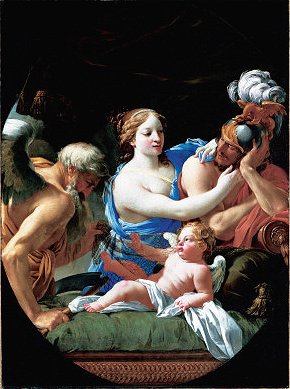 |
|
MARS AND VENUS c.1640
SIMON VOUET, French, 1590 - 1649
Oil on canvas, 571/2 x 421/2 SN 360
By: Marilyn Huebner 4/11/2000
1. The picture shows four people. This is a mythology of Mars and Venus. Labeled allegory.
Chronos is on the left casting a net over Cupid. Venus the women in the center is
seductively caressing the enchanted Mars on the right. The vulture is a symbol of
rapacious lust . Venus is dressed with pearls in her hair which represents grace,
fertility and beauty.
2. In Greek and Roman mythology the painting depicts Venus who fell in love with Mars.
However she is married to Valcon who is a lame blacksmith of the gods. When Valcon finds
out about the love affair he forges a net and secretly sets it over the lovers bed. When
Mars and Venus make love again Valcan admits the gods to see the shameful sight. The gods
were highly amused; one of them even prayed that he too might be so shamed. They laughed
aloud, and for a long time this was the best known story in the whole of heaven. 3. The
artist was popular for his romantic picturesque subject. The style is baroque, and
painterly. |
The oval composition is tight and connected. Vouet has a great sense of composition and
a mastery of lighting effect in the use of strong light and shadow effects with side
lighting that makes the figures stand out against the dark background. He multiplied his
draperies and splashes of color demonstrating his mastery of the human figure studied from
life, embellished by a pearly treatment of the flesh and attention to detail. He executed
numerous portraits with broad brush stokes, the models mouth slightly open and the head
and shoulders turned towards the spectator.
4. Vouet was one of the foremost painters of the 17 Century. Apart of his religious works,
he limited his subject-matter to mythology and allegory, without recourse to the Classical
world. Vouet was in fact a great decorator; and in the first half of the 17 Century, such
a description was an accolade. Although the early Italian works show the influence of
Caravaggio, his work was subsequently modified by the Baroque style. When Louis XIII
summoned him back to France in 1627 he thus brought with him an Italian idiom hitherto
unknown in France that revitalized French painting. His style became highly popular among
Parisian aristocrats who saw in Vouet a painter capable of decorating their hotels and
chateaux in a manner that would rival the palazzi of their Italian counterparts. In 1624
Vouet was elected President of the Accademia di S Luc. In 1627, however he was called back
to France by the King. For ambitious projects for the royal residences. In late 1627 he
executed cartoons (untraced) for an Old Testament series of tapestries that remain the the
Louvre.
|
